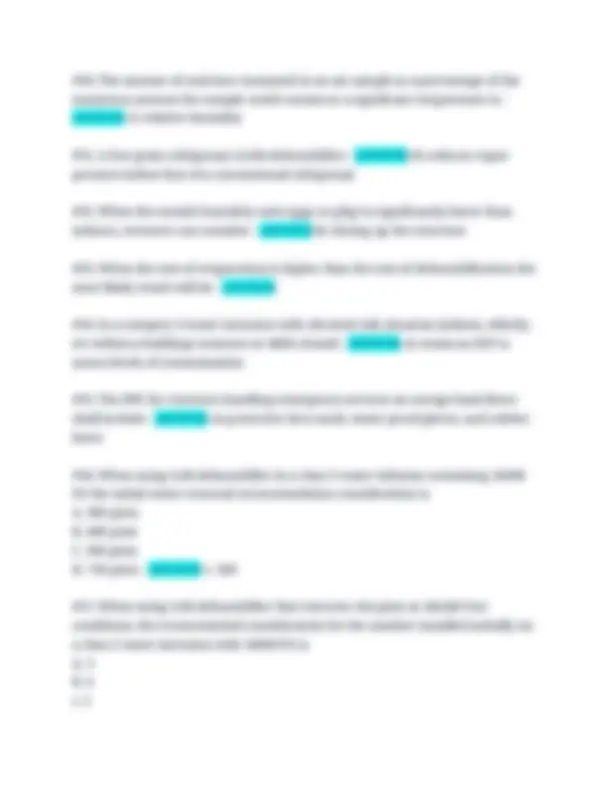








Study with the several resources on Docsity

Earn points by helping other students or get them with a premium plan


Prepare for your exams
Study with the several resources on Docsity

Earn points to download
Earn points by helping other students or get them with a premium plan
Community
Ask the community for help and clear up your study doubts
Discover the best universities in your country according to Docsity users
Free resources
Download our free guides on studying techniques, anxiety management strategies, and thesis advice from Docsity tutors
IICRC WRT Test with complete solutions.
Typology: Exams
1 / 12

This page cannot be seen from the preview
Don't miss anything!







#1. During the inspection process, restorers shall make a reasonable effort to - ANSWER-C. identify and address potential safety hazards #2. A significant amount of water absorption and evaporation load where wet porous materials represent ~5% to ~40% of combined ceiling, walls, and flooring surface areas and where low evaporation materials and assemblies are minimally wet is - ANSWER-B. class 2 #3. Multiple extraction of salvageable materials, especially porous material (e.g. Carpet , cushion) often are required to: - ANSWER-decrease drying time #4. To enhance drying, restorers should manage both ambient temperature and - ANSWER-surface temperatures of affected materials #5. Water damage restoration services should not begin until after the: - ANSWER-restorer has entered into an adequately written contract. #6. Two tools that should be used to properly disengage most stretched-in carpet - ANSWER-Knee kicker and carpet awl #7. When inspecting a water damage structure, restorers should inspect: - ANSWER-all potentially affected areas. #8. Buckled or damaged particle board should - ANSWER-removed and replaced with new material. #9. upon entering a building, professional moisture detection equipment should be used to evaluate and document: - ANSWER-applicable psychrometric conditions and moisture content or level readings.
#10. When wet, a structural material that loses most of its structural integrity, but regains its strength when dry, is: - ANSWER-Concrete #11 Initially, a method of search for abnormal moisture behind ceramic tile or resilient flooring can be accomplished by - ANSWER-using a non-penetrating (non-invasive) moisture meter #12. To minimize damage and reduce drying time, reduce drying time, restorers should: - ANSWER-begin mitigation as soon as safely possible #13. The moisture content of structural materials should be measured with a - ANSWER-A. moisture meter #14. When accessible from below, to dry wet wood subflooring under stone or tile flooring, restorers can use low-humidity air and - ANSWER-D. vapor barrier #15. Biocides designed to destroy or eliminate all forms of microbial life and their spores are - ANSWER-D. sterilizers #16. When carpet is wet it can be delaminated by - ANSWER-D. improper handling and disengaging #17. To minimize or control aerosolized soils or contaminants during restoration, restorers can: - ANSWER-B. install one or more air filtration devices (AFDs) #18. When pre-existing damage is discovered, restorer should - ANSWER-D. document and bring it to the attention of materially interested parties #19. Rapid drying of structural materials is achieved by - ANSWER-A. promoting evaporation and dehumidification or ventilation #20. When carpet and cushion (pad, underlay) are saturated with Category 3 water - ANSWER-B. Both should be removed for proper disposal
#30. A closed drying system is recommended during restoration when - ANSWER- A. outdoor humidity ratio is higher than indoor humidity ratio #31. the rating for water removal of refrigerant dehumidification normally is expressed in pints of water removed in 24 hours at standard AHAM test conditions of - ANSWER-C. 80 F (27C) and 60% RH #32. The temperature at which air reaches 100% relative humidity is known as the - ANSWER-C. dew point temperature #33. Water-saturated carpet cushion (pad, underlay) should be removed and disposed if - ANSWER-A. saturated with Category 2 or 3 water #34. If vapor pressure in ambient air is lower than the vapor pressure in wet materials, the most likely outcome will be - ANSWER-A. condensation #35. Generally, refrigerant dehumidifiers are most efficient in the temperature range of - ANSWER-C. 70F to 90F (21C to 32C) #36. When performing water-damage restoration services and mold growth is discovered, initially restorers should - ANSWER-D. use appropriate PPE, containment or other engineering controls #37. Water that originates from a sanitary water source and does not pose a substantial risk from exposure is - ANSWER-A. category 1 #38. Before applying biocides in water-damaged structures, restorers should - ANSWER-D. turn on the HVAC system to help spread biocides evenly #39. One of the primary purposes of the initial extraction is to - ANSWER-D. contain migrating water
#40. On a structural drying project, if indoor conditions are 88 F (31 C) and 60% RH, condensation begins to occur on structural materials with a surface temperature cooler than - ANSWER-A) 72 F (22 C) #41. The ratio of the mass of water vapor to the mass of dry air in a given moist air sample usually expressed in grams per pound (grams per kilogram) of dry air is the - ANSWER-C. Saturation factor #42. To effectively dry wood sub flooring below sheet vinyl flooring, restorers might need to - ANSWER-B. remove and discard the vinyl covering #43. Water vapor pressure always seeks - ANSWER-D. equilibrium #44. At a humidity ratio of 45 gpp (6.4 g/kg) and a temperature of 60 F (16 C), the relative humidity is - ANSWER-B. 36% #45. After finished wood flooring has been dried to acceptable moisture content - ANSWER-A. appropriate acclimation time may be required before refinishing #46. When carpet has been affected by sewage and should be removed and any materially interested party disagrees, restorers can choose to - ANSWER-B. clean and save the carpet if possible #47. As the air temperature increases, relative humidity - ANSWER-B. decreases #48. Changing a solid directly into a vapor without going through a liquid phase is known as - ANSWER-B) sublimation #49. According to ANSI/IIRC S500, an IEP is an - ANSWER-A) indoor environment professional #50. The greatest amount of water absorption and evaporation load where wet porous materials represent more than ~40% of combined ceiling, walls, and
#60. For safety, air movers shall be equipped with - ANSWER-C. a grounded electrical plug #61. The drying goal for solid hardwood flooring is within - ANSWER-A. 2- percentage points of the dry standard #62. Generally, the drying system that creates the lowest atmospheric vapor pressure is - ANSWER-D. desiccant dehumidification #63. Applying thermal energy directly to wet materials can be used to accelerate evaporation by increasing the temperature and the waters - ANSWER-D. Vapor pressure #64. The atmospheric conditions with the lowest humidity ratio is - ANSWER-A. 40 F AND 80% RH #65. Blowing dry air into wall cavities helps dry them primarily by - ANSWER-D. increasing the rate of evaporation #66. The atmospheric condition equivalent to a humidity ratio of 54 gpp (7.8 g/kg) is - ANSWER-90 F and 37% RH #67. When air is holding the maximum amount of water vapor possible at the existing temperature and pressure the air is - ANSWER-D) saturated #68. Water that contains significant contamination and has the potential to cause discomfort or sickness if contacted or consumed by humans is - ANSWER-B) category 2 #69. Of the sub flooring materials listed below, the one most resistant to water damage is - ANSWER-A) plywood
#70. After removing bulk water, if required, concrete should be dried using a combination of controlled dry air movement and atmospheric temperature or - ANSWER-A) heat energy transfer #71. When category 2 water enters a building the contaminated material that should be disposed is - ANSWER-D) carpet cushion (pad, underlay) #72. The primary purpose of the "skin" on most carpet cushion (pad, underlay) is to - ANSWER-C. Ease carpet stretching during installation #73. When moisture causes wood flooring to expand (swell) with edges higher than the centers the planks are - ANSWER-D) cupped #74. When placing airmovers in a building that had water intrusion, the formula begins with each room receiving this many airmovers prior to affected area and inset/offset calculations - ANSWER-A) 1 #75. When significant Carpet Delamination is discovered the restorer should - ANSWER-D) document, communicate with materially interested parties, and most often recommend replacement #76. When the temperature of absorbed moisture in materials is increased, more energy is increased causing the - ANSWER-C. Evaporation to increase #77. Reducing the water vapor content of air is - ANSWER-A) dehumidification #78. When indoor conditions are 75 F (24 C) and 55% RH and no heating system is available the most appropriate outdoor conditions for considering an open drying system would be - ANSWER-c #79. Wallboard covered with vinyl wallpaper can require special drying procedures - ANSWER-A
#90. The amount of moisture contained in an air sample as a percentage of the maximum amount the sample could contain at a significant temperature is - ANSWER-C) relative humidity #91. A low-grain refrigerant (LGR) dehumidifier - ANSWER-D) reduces vapor pressure below that of a conventional refrigerant #92. When the outside humidity ratio (gpp or g/kg) is significantly lower than indoors, restorers can consider - ANSWER-B) closing up the structure #93. When the rate of evaporation is higher than the rate of dehumidification the most likely result will be - ANSWER- #94. In a category 3 water intrusion with elevated risk situation (infants, elderly, etc within a building) restorers or MIPs should - ANSWER-A) retain an IEP to assess levels of contamination #95. The PPE for restorers handling emergency services on sewage back flows shall include - ANSWER-A) protective face mask, water-proof gloves, and rubber boots #96. When using LGR dehumidifier in a class 3 water infusion containing 16000 ft3 the initial water removal recommendation consideration is A. 300 pints B. 400 pints C. 500 pints D. 750 pints - ANSWER-c. 500 #97. When using LGR dehumidifier that removes 144 pints at AHAM Test conditions, the recommended consideration for the number installed initially on a class 2 water intrusion with 36000 ft3 is A. 3 B. 4 c. 5
D. 6 - ANSWER-c. 5 #98. When using conventional refrigerant dehumidifier that removes 115 pints at AHAM test with water intrusion with 22000 ft3 is - ANSWER-B. #99. When using a desiccant dehumidifier that is rated to process 630 clm, the initial recommended number for consideration on a class 4 water intrusion in 4000 ft building with a 9 foot ceiling height A. 7 B. 5 C. 3 D. 1 - ANSWER-C. 3 #100. After physically removing excess water, the time required to dry wet materials is influenced most by the A. Equilibrium moisture content B. Rate of evaporation C. Equilibrium relative humidity D. Fiber saturation point - ANSWER-B. Rate of evaporation #101. Restorers should inspect, record, and monitor a restoration job at least A. Weekly B. Daily C. Every other day D. Every 3 days - ANSWER-B. Daily #102. Refrigerant dehumidifier removes water vapor from the air through A. Condensation B. Absorption C. Evaporation D. Adsorption - ANSWER-A. Condensation #103. To determine an initial dehumidification capacity recommendation to effectively dry an affected area, restorers should know the - ANSWER-c.